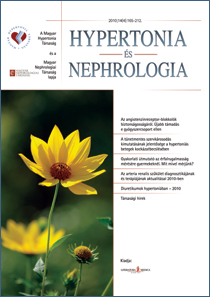The eLitMed.hu medical portal uses computer cookies for convenient operation. Detailed information can be found in the Cookie-policy.
Hypertension and nephrology - 2010;14(04)
Content
[On the safety of angiotensin-receptor blockers - A new attack on this drug class]
[Up until now, angiotensin-receptor blockers have been considered to be the safest cardio-, cerebro-, reno- and vasculoprotective drugs. In a previous metaanalysis, ARBs were accused of increasing the risk of myocardial infarction, but a number of metaanalyses and randomised, controlled trials have disproved this hypothesis. In a recent metaanalysis, ARBs were associated with an increased risk of tumours. The author reviews this issue, discusses the flaws of the above metaanalysis and, on the basis of the most up-to-date data in the literature, expert opinions and official statements (FDA, EMA), concludes that members of this drug class should continue to be used according to their approved indications, which is supported by their cardio-, reno-, cerebro- and vasculoprotective effects demonstrated in a number of appropriate, large-scale clinical studies.]
[The importance of assessing subclinical organ damage in risk prediction of hypertensive patients]
[As the cardiovascular risk influences the quality and intensity of blood pressure lowering therapy, the goal blood pressure values and the frequency of medical control of hypertensive patients, as well as global risk assessment has an important role in the management of hypertension. In the last couple of years many data have been accumulated showing the poor prognostic value of traditional cardiovascular risk factors. This is the reason why recent Hungarian and international guidelines on the management of hypertension advise the screening for subclinical organ damage. Our goal was to summarize the importance of subclinical organ damage by discussing recently published literature on this topic. An overview has been made on the markers of vascular subclinical damage, like carotid atherosclerosis proved with carotid ultrasonography, peripheral arterial disease assessed with ankle-brachial pressure index measurements and vascular rigidity defined with pulse wave velocity measurements. The prognostic values of myocardial hypertrophy assessed with ECG and/or echocardiography and renal damage proved with decreased estimated glomerular filtration rate and proteinuria are also discussed. Summing up what has been said so far, the assessment of subclinical organ damage has a role in cardiovascular risk prediction, however more randomized and prospective studies have to be performed to define the most suitable (i.e. the most reliable and the most cost-effective) markers for this purpose.]
[Evaluation of arterial stiffness in children. Guidelines for the practice]
[Assessment of early atherosclerosis and decreased arterial elasticity to recognise the cardiovascular dysfunction in high-risk patients has gained importance in the past decade. Since 1990, more than 630 papers have been published in the adult and pediatric literature. Methods of early risk assessment in adults are well determined in international recommendations. The aim of the present work is to review the suggestions of the American Heart Association helping us to find the most appropriate method for the non invasive methods of cardiovascular assessment of young adults and children. Furthermore, multicentric studies should be conducted to create a Framingham like score system for pediatric patients, to render cardiovascular risk assessment much easier for the every day routine.]
[Update on diagnostics and therapy of the renal artery stenosis in 2010]
[Results of epidemiological studies indicate the atherosclerotic renal artery stenosis is a common condition, thus development of its diagnostics and therapy has significant importance. Renal artery narrowing can cause hypertension, renal function decline, cardiac failure and the increased cardiovascular risk seriously affects survival perspective of the patients. The evolution of MR technology has a prominent role in renovascular diagnostics. Beyond the detection of arterial stenosis this technique is capable of the functional characterization of the stenosis and the detailed description of the regional kidney tissue damage. Based on the results of clinical studies the relevance of revascularization of the renal artery stenosis remains uncertain. The trials focusing on this issue show methodological imperfections. It remains to be elucidated whether these methodological problems will be tackled in the future based on the present information. This review focuses on the actual findings corresponding to these problems.]
[Diuretikumok hypertoniában - 2010]
[Diuretics (especially thiazide derivatives and indapamide that also has vasodilator efficacy) are considered as first line treatment in hypertension. They are particularly favourable in the treatment of overweight, elderly, isolated systolic hypertensive patients suffering from type 2 diabetes and metabolic syndrome or in mild renal and cardiac insufficiency. They can be ideally combined with other antihypertensive agents (primarily with angiotensin-converting enzyme inhibitors, angiotensin receptor blocking agents és béta-blockers). If hypertension is associated with left ventricular hypertrophy or stroke indapamide is the appropriate choice. In case of left ventricular dysfunction and heart failure thiazide and/or furosemide is the adequate option. Low dose diuretics have no clinically relevant side effects and reduce cardiac mortality to the same extent as other pharmaceutical interventions.]
1.
Clinical Neuroscience
Is there any difference in mortality rates of atrial fibrillation detected before or after ischemic stroke?2.
Clinical Neuroscience
Factors influencing the level of stigma in Parkinson’s disease in western Turkey3.
Clinical Neuroscience
Neuropathic pain and mood disorders in earthquake survivors with peripheral nerve injuries4.
Journal of Nursing Theory and Practice
[Correlations of Sarcopenia, Frailty, Falls and Social Isolation – A Literature Review in the Light of Swedish Statistics]5.
Clinical Neuroscience
[Comparison of pain intensity measurements among patients with low-back pain]1.
Clinical Neuroscience Proceedings
[A Magyar Stroke Társaság XVIII. Kongresszusa és a Magyar Neuroszonológiai Társaság XV. Konferenciája. Absztraktfüzet]2.
3.
Journal of Nursing Theory and Practice
[A selection of the entries submitted to the literary contest "Honorable mission: the joys and challenges of our profession" ]4.
Journal of Nursing Theory and Practice
[End of Life and Palliative Care of Newborns in the Nursing Context]5.
Journal of Nursing Theory and Practice
[Aspects of Occupational Health Nursing for Incurable Patients ]


